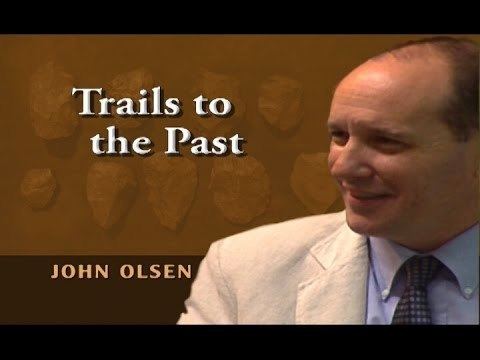Name John Olsen | ||
 | ||
John W. Olsen at Press Conference 4.28.11 Alliance for Retired Americans
John W. Olsen, Ph.D., is an American archaeologist and paleoanthropologist specializing in the early Stone Age prehistory and Pleistocene paleoecology of eastern Eurasia. Olsen is Regents' Professor Emeritus of Anthropology and Executive Director of the Je Tsongkhapa Endowment for Central and Inner Asian Archaeology at the University of Arizona in Tucson, Arizona, USA. He is also a Leading Researcher at the Institute of Archaeology and Ethnography of the Russian Academy of Sciences' Siberian Branch (Ведущий научный сотрудник; Институт археологии и этнографии, CO PAH) in Novosibirsk and Guest Researcher at the Chinese Academy of Sciences' Institute of Vertebrate Paleontology and Paleoanthropology (IVPP; 中国科学院古脊椎动物与古人类研究所客座研究员) in Beijing where he is Co-Director of the Zhoukoudian International Paleoanthropological Research Center (周口店国际古人类研究中心联席主任). Olsen is also a Foreign Expert affiliated with The Yak Museum in Lhasa, Tibet (西藏牦牛博物馆国外专家).
Contents
- John W Olsen at Press Conference 42811 Alliance for Retired Americans
- Early life and education
- Career
- Principal awards honorary degrees and elected memberships
- Selected publications
- References
Olsen's role as Co-Director of the Joint Mongolian-Russian-American Archaeological Expeditions (Монгол-Орос-Америкийн Археологийн Хамтарсан Экспедици, Хамтран захирал; Российско-Монгольско-Американская Совместная Археологическая Экспедиция, Cодиректор) has been the nexus of his research activities since 1995, even as the Expedition's geographical focus has expanded to include Xinjiang (beginning in 2004) and Tibet (beginning in 2006) in China as well as other ethnic Mongol and ethnic Tibetan territories in Russia, the independent Central Asian republics of the former USSR, and the Himalayan region.
Olsen's research emphasizes the Paleolithic archaeology of arid lands and high elevations in Central and Inner Asia, especially Mongolia and Tibet. His interests include Quaternary paleoecology and the impact of environmental degradation on prehistoric societies; cultural ecology and environmental archaeology with emphasis on zooarchaeology, especially animal husbandry among pastoral and nomadic societies; and spatial analysis in archaeology, including applications of remote sensing and geographic information systems. Olsen has conducted collaborative archaeological fieldwork in the United States (Florida & Arizona), Colombia, Belize, the Philippines, Egypt, Sudan, the People's Republic of China (Tibet, Qinghai, Xinjiang, Inner Mongolia, Hebei, Shanxi, Shaanxi, Gansu, & Ningxia), Việt Nam, Kazakhstan, Uzbekistan, Turkmenistan, Russia (Siberia), and Mongolia (Mongol Uls). As of 2017, he has been director or co-director of 19 interdisciplinary archaeological field expeditions.
Early life and education
John Olsen was born in Concord, Massachusetts in 1955, the only offspring of Stanley John Olsen (1919–2003; vertebrate paleontologist and zooarchaeologist) and Eleanor Louise Vinez Olsen (1917-2016; executive assistant, botanist and homemaker).
Olsen spent his formative years in Tallahassee, Florida where he lived until he moved to Tucson, Arizona with his parents in 1973. Following his early graduation from Florida High School in Tallahassee after completing the eleventh grade, Olsen attended Florida State University as a freshman (1972–1973) and subsequently received Bachelor of Arts degrees with Highest Distinction and Honors in Anthropology and Oriental Studies from the University of Arizona (1976). Olsen holds Master of Arts (1977) and Doctor of Philosophy (1980) degrees in Anthropology from the University of California, Berkeley where his principal advisors were Glynn Ll. Isaac (dissertation chair), J. Desmond Clark, F. Clark Howell, and William A. Clemens, Jr.
Career
After completing his doctoral degree at Berkeley in 1980, Olsen was appointed visiting assistant professor in the Departments of Anthropology and Oriental Studies at the University of Arizona, where he taught until 1982. From 1982 to 1984, Olsen was a post-doctoral research associate of the Institute of Archaeology at University College, London where he taught courses, planned and carried out research expeditions in China and North Africa, and translated and co-edited a book on Chinese paleoanthropology published by Academic Press in 1985.
Olsen joined the permanent faculty of the University of Arizona as an assistant professor of Anthropology in 1984. He was promoted to associate professor with tenure in 1988 and to full professor in 1994. In 2005, Olsen was awarded a Regents' Professorship.
Olsen retired from teaching at the University of Arizona in 2016 to accept research positions with the Chinese and Russian Academies of Sciences.
In 1991–1992 Olsen held a Fulbright Research and Lecturing Award at Kazakh State University (now Al-Farabi Kazakh National University; Əл Фараби атындағы Қазақ Ұлттық Университеті) in Almaty. Olsen's administrative appointments have included Resident Representative in Beijing for the U.S. National Academy of Sciences (1990–1991) and Head of the Department (now School) of Anthropology at the University of Arizona (1994–1995 and 1998–2008).
Over the past three decades, Olsen has accrued slightly more than US$1.9 million in sponsored support of his and his students' research as well as spearheading successful development and fundraising activities on behalf of the University of Arizona's School of Anthropology.
